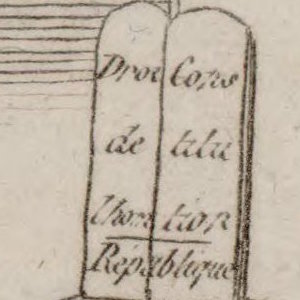Early Modern (1450 CE - 1800 CE)

The Counterrevolution
This cartoon mocks all the leading figures of the "Counterrevolution," including the former royal family and its blood relatives, plus the clergy, the nobility, and specific individuals, such as Mirabeau, who had supported the monarchy in the early years of the Revolution.

Tyranny Tremble
A very potent image associating France's revolutionary war with an attack on tyrants. Contemporaries would have understood the target, "tyrants," to be the monarchs.

Sword of Sieyès
This ceremonial sword, created for one of the directors in 1799, is presented symbolically as an instrument to defend the "people." Indeed, the war effort was waged for the populace against the perceived injustices of the old regime and its remnants in and outside of France.

Sword Hilt with Revolutionary Icons—Liberty
This sword, an actual artifact of the revolutionary wars, shows how strongly French officers and soldiers believed themselves to be fighting for the defense of liberty, which is represented by the woman holding the balance and by the Phrygian bonnet on a pike, both visible in the hilt.

Noble Act of 500,000 Republicans
The revolutionary wars, which would continue in one form or another until Napoleon’s defeat in 1815, were different from other conflicts in early modern Europe.

Jemmapes, 6 November 1792
This engraving of the battle of Jemappes, preromantic in its composition and style, depicts a group of French citizen–soldiers bravely risking themselves under the banner of liberty and overcoming all foes in marching to victory—a motif that would become common in the nineteenth century.

French Victory at the Battle of Jemmappes
This engraving first appeared in the newspaper Révolutions de Paris and shows the French General Charles–François Dumouriez entering the city of Mons after having led French forces to their first truly decisive victory of the war on 6 November 1792.

March of the Powers Allied against France
This engraving uses classical figures to depict allegorically an alliance of Prussia, Britain, and Austria, represented as "Tyranny, Hypocrisy, and Pride," who seek to divide the map of France among themselves, while the French Nation prepares to resist so as to bring peace and tranquility to all

Gallic Declaration of War, or, Bumbardment of all Europe
This scatological English cartoon mocks France’s claim that it was going to war for "liberty," suggesting instead that France’s body politic is ill and that England needs to fight back to defend itself from such sickness.

The Queen of Louis XVI King of France at the Guillotine, 16 October 1793
An idealized portrait of Marie Antoinette at the moment of death. Unlike the pale, aged woman the contemporaries observed, this later print memorialized a beautiful, absolutely pure, woman.